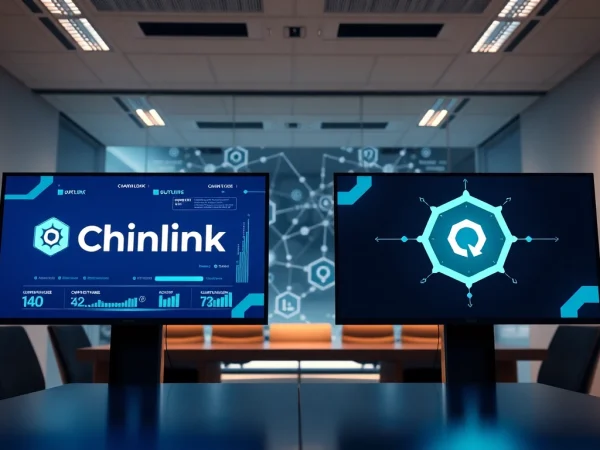Chainlink vs Quant: Key Insights into Blockchain Infrastructure Choices
Understanding Blockchain Infrastructure
What is Blockchain Technology?
Blockchain technology has emerged as a revolutionary method of data storage and transfer, providing a decentralized ledger system that is secure, transparent, and immutable. At its core, a blockchain is a series of blocks that securely record transactions across a network of computers, ensuring that once information is added, it cannot be altered without consensus from the network participants. This fundamental trait makes blockchains exceptionally robust against fraud, unauthorized access, and data tampering.
Blockchain technology can be visualized as a digital ledger that records various transactions in a chronological manner. Each block in the chain contains a list of transaction records, a timestamp, and a cryptographic hash of the previous block, forming a secure link. This design not only enhances security but also facilitates the verification of data without the need for intermediaries, thereby streamlining processes across various industries.
Importance of Infrastructure in Blockchain
The underlying infrastructure of blockchain technology is critical for its functionality and adoption. A well-architected infrastructure can enhance the scalability, interoperability, and security of blockchain networks. Infrastructure encompasses the hardware, software, protocols, and services that enable the deployment and operation of blockchain solutions. This includes nodes that validate transactions, smart contracts that automate processes, and oracles that provide off-chain data to on-chain applications.
As blockchain technology continues to evolve, the importance of robust infrastructure becomes increasingly apparent. The capacity of a blockchain to support decentralized applications, facilitate cross-chain communication, and ensure data integrity hinges on its infrastructure. Therefore, choosing the right blockchain solutions and understanding their underlying components is crucial for businesses looking to leverage this transformative technology.
Different Types of Blockchain Solutions
Blockchain solutions can be broadly categorized into three types: public blockchains, private blockchains, and consortium blockchains. Public blockchains, such as Bitcoin and Ethereum, are open and accessible to anyone, providing high levels of transparency and security but often facing challenges such as scalability and speed.
On the other hand, private blockchains are restricted to a specific group of users, offering more control and privacy—this is suitable for businesses that prioritize confidentiality while still wanting to leverage blockchain capabilities. Consortium blockchains fall somewhere in between, where multiple organizations collaborate and govern the network, sharing both the benefits and responsibilities.
Each type of blockchain serves specific purposes and addresses different challenges, and organizations must carefully evaluate their needs to choose the most appropriate solution, particularly when comparing options like chainlink vs quant.
Chainlink: Data Reliability and Smart Contracts
Overview of Chainlink Technology
Chainlink is a decentralized oracle network that connects smart contracts on various blockchains with real-world data. By providing off-chain data to on-chain applications, Chainlink enhances the functionality of smart contracts, enabling them to operate based on real-time events and external information. Its architecture includes multiple components such as nodes, an incentive system, and data sources that work collectively to ensure data accuracy and reliability.
The primary function of Chainlink is to bridge the gap between smart contracts and external data sources through oracles. This is essential because most smart contracts require access to real-world data to execute functions such as payment processing based on complex conditions involving external events (like weather, stock prices, etc.). Without a reliable way to access this data, smart contracts remain limited and less useful.
Use Cases for Chainlink
Chainlink has a wide range of applications across various sectors. In finance, it can facilitate automated payments triggered by specific data points, such as international exchange rates or market conditions. For insurance, Chainlink can automate claims processing by using real-time data from external sources. Moreover, in the gaming industry, Chainlink can help in certifying in-game assets through verifiable randomness and fair distribution systems.
Additionally, decentralized finance (DeFi) heavily relies on Chainlink’s technology. By accessing robust price feeds, decentralized exchanges can execute trades at accurate rates, enhancing user trust and oversight. Overall, Chainlink’s applications reflect its versatility and crucial role in developing more efficient and reliable smart contracts.
Benefits of Implementing Chainlink
Implementing Chainlink presents numerous benefits including enhanced security, as decentralized nodes validate data before it reaches smart contracts, minimizing the risk of manipulation. Chainlink also offers increased operational efficiency by automating processes that typically require manual input, thus saving time and resources.
Moreover, Chainlink’s interoperability allows it to function across multiple blockchains, which means organizations can utilize its capabilities irrespective of their chosen blockchain technology. Additionally, as a decentralized solution, Chainlink reduces reliance on central authorities, fostering greater trust among users and stakeholders.
Quant: Interoperability between Blockchains
What is Quant and Its Core Features?
Quant is an innovative technology designed to facilitate interoperability between different blockchains. Its objective is to create an ecosystem where various blockchains can communicate and interact with one another, effectively eliminating the silos that exist in the current fragmented blockchain landscape. The core feature of Quant is its Overledger technology, which allows seamless integration and communication across multiple blockchain networks while maintaining their individual characteristics and protocols.
Quant’s architecture includes a unique four-layer model that encompasses the network, application, interface, and transaction layers. This modular approach enables users to develop and deploy applications that operate across different blockchains, enhancing functionality while promoting a standardized method of interaction.
Use Cases for Quant Solutions
Quant’s interoperability capabilities open up a multitude of use cases across various sectors. For example, financial institutions can utilize Quant to enhance cross-border payments by enabling different blockchain networks to process transactions seamlessly. Healthcare systems can benefit from interoperability regarding patient data sharing among providers, enhancing care coordination while maintaining patient privacy.
In the supply chain industry, Quant can facilitate real-time data sharing and verification among multiple parties, enhancing transparency and reducing fraud. Additionally, by allowing different decentralized applications (dApps) to interact effortlessly, Quant can stimulate innovation and collaboration, ultimately advancing the entire blockchain ecosystem.
Benefits of Using Quant for Blockchain Integration
The implementation of Quant technology carries several advantages. Its interoperability promotes a more efficient ecosystem by enabling greater collaboration between various blockchain networks, thus improving transaction speed and reducing costs. Organizations can leverage Quant to break down barriers presented by disparate technologies, allowing for unified solutions that enhance user experiences and operational processes.
Quant’s ability to interact with all major blockchains also means that businesses are not locked into a specific technology; they can choose the best platforms according to their needs without worrying about compatibility issues. Additionally, by simplifying complex processes associated with blockchain integration, Quant can reduce the time and resources required for deployment, leading to faster adaptation and implementation within businesses.
Chainlink vs Quant: Direct Comparison
Architecture and Functionality
When comparing Chainlink and Quant, the architectural distinctions are evident. Chainlink focuses primarily on enhancing the functionality of smart contracts by providing reliable off-chain data via decentralized oracles. Its architecture thrives on connecting various data sources with smart contracts, allowing them to respond to real-time information. Conversely, Quant leverages Overledger technology to connect different blockchains, focusing on enabling interoperability rather than solely enhancing smart contract functionalities.
While both technologies serve crucial roles in the blockchain ecosystem, their core functionalities highlight different priorities. Chainlink adds value by ensuring smart contracts operate with accuracy, while Quant enhances overall blockchain interoperability, allowing diverse systems to work together in harmony. This comparison highlights the versatility of both solutions, with each providing specific benefits depending on the use case at hand.
Market Presence and Performance Metrics
Both Chainlink and Quant have established strong market presence, though they operate in distinct niches. Chainlink has gained substantial traction within the DeFi space, where it is often regarded as the leading oracle solution, powering countless applications. Its market capitalization reflects its central role in the success of many DeFi projects, underlining its widespread adoption.
Quant, on the other hand, targets a broader scope with its interoperability solutions. While it may not have the same level of market penetration in DeFi as Chainlink, its potential for growth is vast as cross-chain solutions become increasingly necessary. Performance metrics for both projects indicate their strong foundations, with Chainlink showing a robust transaction throughput and Quant achieving significant partnerships for its Overledger technology capabilities.
Pros and Cons of Each Blockchain Solution
Understanding the benefits and drawbacks of each solution provides clarity for businesses considering their blockchain options. Chainlink’s primary advantage is its reliability as an oracle solution, which enhances smart contract execution accuracy. However, its reliance on external data sources could pose risks if those sources are compromised or inaccurate.
Quant’s main advantage lies in its capability to enable interoperability, making it an excellent choice for organizations looking to connect multiple blockchains. Its modular architecture allows for flexible use cases, though it may face challenges in mainstream adoption as companies standardize integration practices. Balancing these pros and cons will be essential for businesses evaluating which solution aligns with their strategic objectives.
Making the Right Choice: Chainlink versus Quant
Evaluating Your Business Needs
Determining whether to implement Chainlink or Quant ultimately comes down to an organization’s specific needs and goals. Businesses aiming to enhance their smart contracts and directly interact with off-chain data may find Chainlink indispensable. In contrast, organizations seeking cross-chain solutions to facilitate communication between disparate blockchain networks will benefit significantly from Quant’s capabilities.
A thorough evaluation process should include analyzing existing workflows, identifying key pain points, and assessing the potential benefits each solution offers. Engaging stakeholders throughout the decision-making process can also aid in understanding which technology aligns best with organizational objectives.
Future Trends in Blockchain Technology
The future of blockchain technology is exciting, with trends indicating a growing emphasis on solutions that prioritize interoperability, scalability, and security. As the demand for decentralized applications increases, the need for reliable data sources and interconnectivity between systems will become critical. Both Chainlink and Quant stand to benefit significantly from these trends, as their respective technologies address essential gaps in the current blockchain landscape.
Moreover, advancements in privacy solutions, such as zero-knowledge proofs and confidential computing, are also likely to influence the evolution of blockchain technology, enhancing data security while maintaining transparency. Organizations that adopt technologies like Chainlink and Quant early on may better position themselves in this rapidly evolving sector.
Conclusions and Recommendations
In conclusion, Chainlink and Quant present two distinct yet valuable approaches to blockchain technology, serving different purposes and addressing unique challenges within the ecosystem. Businesses must carefully consider their immediate and long-term needs when evaluating these solutions to determine which best aligns with their technological and operational objectives.
As blockchain technology continues to mature, embracing solutions that facilitate better data management and interconnectivity will be essential for any organization aiming to thrive in this innovative landscape. Whether opting for Chainlink’s oracle infrastructure or Quant’s interoperability solutions, making informed choices will pave the way for future success in blockchain initiatives.







